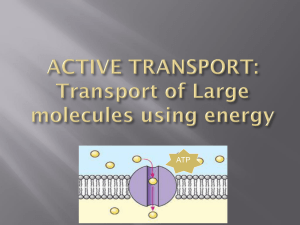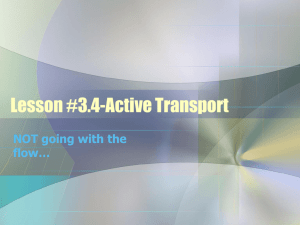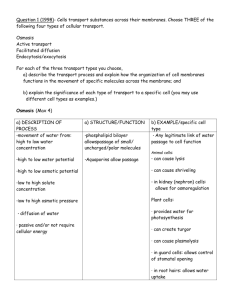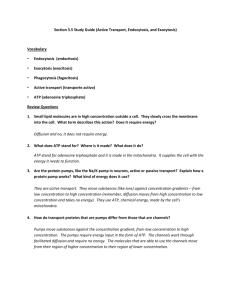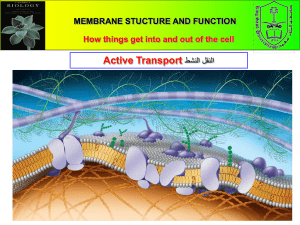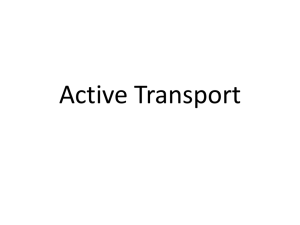Active Transport
advertisement
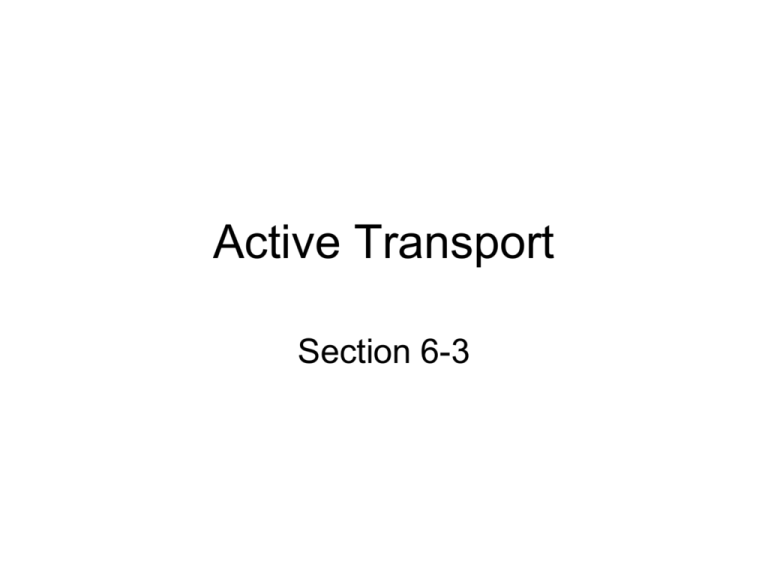
Active Transport Section 6-3 OBJECTIVES • Distinguish between passive and active transport. • Explain how the sodium-potassium pump operates. • Compare and contrast endocytosis and exocytosis. CELL MEMBRANE PUMPS • 1. Cells often move molecules across the membrane AGAINST a Concentration Gradient. • 2. From an area of LOW Concentration to areas of HIGH Concentration. • 3. Moving molecules AGAINST the Concentration Gradient REQUIRES ENERGY. (ACTIVE TRANSPORT) • 4. WHEN ENERGY IS USED TO TRANSPORT MOLECULES ACROSS THE MEMBRANE, THE PROCESS IS CALLED ACTIVE TRANSPORT. • 5. Active Transport often involves CARRIER PROTEINS like those in Facilitated Diffusion. CELL MEMBRANE PUMPS ATP CELL MEMBRANE PUMPS • 6. The CARRIER PROTEINS act as PUMPS that USE ENERGY to move IONS and Molecules across the membrane. The Carrier Proteins that serve in Active Transport are often called CELL MEMBRANE PUMPS. • 7. ACTIVE TRANSPORT is especially IMPORTANT in MAINTAINING ION CONCENTRATION IN CELLS AND BETWEEN CELLS. • 8. SODIUM-POTASSIUM PUMPS ARE IMPORTANT FOR MUSCLE CONTRACTIONS, THE TRANSMISSION OF NERVE IMPULSES, AND THE ABSORPTION OF NUTRIENTS. • 9. SODIUM-POTASSIUM PUMPS IN ANIMAL CELLS PUMP SODIUM IONS OUT, AND POTASSIUM IN, UP THEIR CONCENTRATION GRADIENT. (Figure 5-6) ATP CELL MEMBRANE PUMPS • 10. ATP supplies the energy needed by carrier proteins. • 11. In Plants, ACTIVE TRANSPORT enables roots to absorb nutrients from the soil. • 12. Plant Nutrients are more concentrated inside the roots than in the surrounding soil. • 13. WITHOUT ACTIVE TRANSPORT, NUTRIENTS would DIFFUSE OUT OF THE ROOTS. • 14. Active Transport in the root cell membranes enables the plant to absorb the nutrients against the Concentration Gradient. BULK TRANSPORT: ENDOCYTOSIS AND EXOCYTOSIS • 1. Some Molecules, such as COMPLEX PROTEINS, are too LARGE to cross the Cell Membrane. • 2. These Substances cross the Membrane by BULK TRANSPORT. • 3. IN BULK TRANSPORT, LARGE MOLECULES, FOOD, AND OTHER SUBSTANCES ARE PACKAGED IN MEMBRANE-BOUND SACS CALLED A VESICLE AND MOVED ACROSS THE MEMBRANE. • 4. THERE ARE SEVERAL TYPES OF BULK TRANSPORT, INCLUDING ENDOCYTOSIS, EXOCYTOSIS, PINOCYTOSIS, AND PHAGOCYTOSIS. BULK TRANSPORT: ENDOCYTOSIS AND EXOCYTOSIS • 5. During ENDOCYTOSIS the Cell Membrane (figure 5-7) Folds into a POUCH that Encloses the Particles. • 6. The Pouch pinches off INSIDE the Cell to form a VESICLE (membrane-wrapped bubbles). • 7. The VESICLE can then fuse with other Organelles (LYSOSOMES) or Release its contents into the Cytoplasm. BULK TRANSPORT: ENDOCYTOSIS AND EXOCYTOSIS • 8. PINOCYTOSIS AND PHAGOCYTOSIS ARE TWO TYPES OF ENDOCYTOSIS. • 9. PINOCYTOSIS IS SOMETIMES CALLED "CELL DRINKING". • 10. Solutes or Fluids outside the Cell Membrane can be brought into the Cytoplasm by PINOCYTOSIS. • 11. PHAGOCYTOSIS IS LIKE PINOCYTOSIS, EXCEPT THE CELL ENGULFS A FOOD PARTICLE OR OTHER CELLS INSTEAD OF A DROP OF LIQUID. "CELL EATING" • 12. The Food Vesicle can then Fuse with a LYSOSOME that contains DIGESTIVE ENZYMES. • 13. White Blood Cells (WBC, PHAGOCYTES) Destroy Bacteria and other Unwanted Cells by Phagocytosis. BULK TRANSPORT: ENDOCYTOSIS AND EXOCYTOSIS • • • • • 14. These cells engulf and digest millions of old RBC in your body daily. 15. EXOCYTOSIS IS THE OPPOSITE OR REVERSE OF ENDOCYTOSIS. (Figure 5-8) 16. DURING EXOCYTOSIS, WASTE AND CELL PRODUCTS LEAVE THE CELL. 17. Products MADE IN the Cell are Packaged in GOLGI VESICLES, which then FUSE with the Cell Membrane and Secrete Material OUT OF THE CELL. 18. MUCUS AND WASTE PRODUCTS ARE MATERIALS SECRETED BY EXOCYTOSIS. Take a Quiz Over Plasma Membranes and Cellular Transport
